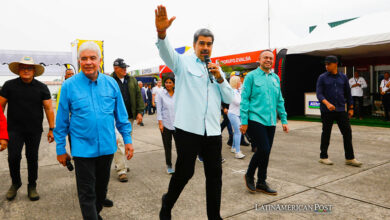Refugees in a crystal palace: Salcedo’s efforts for remembrance
Colombian artist Doris Salcedo has installed her latest art work, “Palimpsest”, at the Museo Reina Sofía, Madrid

Doris Salcedo is one of Colombia’s most important contemporary artists, internationally recognized for her works of denunciation. Typically, she tends to focus on the consequences and the victims of her home country’s armed conflict. However, she also looks at other conflicts around the world. This time, she looks at the drama of the refugees who drown trying to leave their countries in the Atlantic and in the Mediterranean year after year. The installation consists of stone stabs and a complex hydraulic engineering system that allows the names of men and women who died trying to escape their conflicted countries in drops of water. These names are shown temporarily and intermittently. Other names are engraved IGNORE INTO the stone. This way, Salcedo reminds the world of these victims, but also comments on how the media and society tend to forget them quickly, and group them all IGNORE INTO an anonymous collective of refugees who drowned. The installation will be in the Reina Sofía’s Palacio de Cristal, in the Parque de El Retiro, until April of 2018.
This is not the first time Salcedo works with the names of forgotten victims. Last year, after the “no” to the peace agreement referendum won in Colombia, Salcedo covered the country’s most important square, Plaza de Bolívar, in pieces of white fabric with the names of the victims of the armed conflict with the FARC written with ashes. With the help of people who wanted to protest the victory of the “No”, mostly students, the fabrics were sown together until they covered the square. This was the artist’s way of saying that the “No” was a mistake, that most people that had voted against president Santos’s peace efforts were voting against the victims. A year later, with many disagreeing with Salcedo’s opinion, most will remember the photographs of the Plaza de Bolívar covered in names.
How the experts describe Salcedo’s work:
Museo Reina Sofía’s website explains Salcedo’s work as: “indivisible from the context of Colombia and the so-called “culture of the wound”; that is, the link between violence, privacy and public space. Exposing and probing this wound through art, yet standing back from the sensationalism and frivolity found in certain corners of the mass media, constitutes one of her primary aims”. The museum also states that “Her work tackles the relationship art bears with trauma and its capacity to publicly reveal and exorcise grief in the face of loss, thus adopting the repetition and seriality of minimalist sculpture to define a silent space and poignancy that is conducive to memory and remembrance. Yet, contrasting with practices in minimalism, the artist references specific violent episodes in recent Colombian history in such a way that her installations sit halfway between relic – personal objects, furniture, hair, clothes — and anti-monument, granting visibility to victims deprived of public recognition”.
This is Salcedo’s new milestone
Salcedo is one of the better known Colombian artists in the international art sphere. This could be due, at least in part, to the high denunciation that accompanies her installations and sculptures. Her work has already been exhibited in some of the world capitals of modern art, such as Chicago, New York City, and London. This takeover of one of Madrid’s most well-known spaces, visited by hundreds of tourists every year, marks a new mile stone in Salcedo’s career, particularly because it touches upon one of Europe’s most controversial political crises in recent history.
Latin American Post | Laura Rocha Rueda





